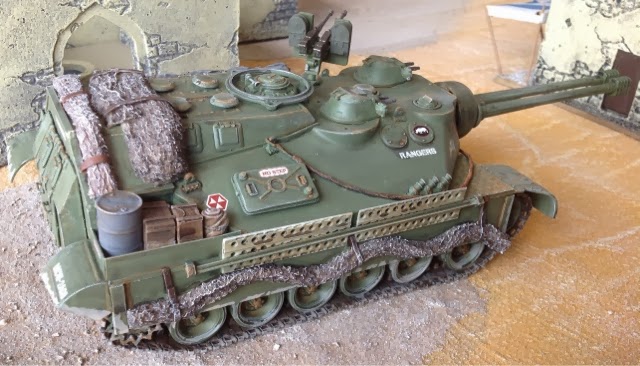Friday, 7 March 2014
Allied heavy armour for Babylon
Pershing in Babylon
Allied armoured vehicle Dustifications
The discovery of how to use VK technology by Allied forces did not mean an automatic change to new combat vehicle designs, even in the manufacturing powerhouse of the USA. Non US Allied countries especially the UK; Canada and Australia had been producing for years conventional tanks and armoured vehicles which supported their forces across the globe. Suddenly new Axis and SSU walkers started to appear on the battlefield and there was now an urgent need to upgrade conventional designs to enable them to continue fighting until VK advanced armoured units arrived.
There were numerous battlefield modifications made by the Allied mechanics, some were successful but many failed dismally. It was usually simple design modifications that worked the best. The Australians took their Bren Carriers and up-armoured them and added a quad 50 calibre machine gun (T2 D3). This was a simple modification as the Aussies had already started to mount 2 pound anti-tank guns on them and the chassis was not overloaded. These very fast machines were used to great affect against the invading Japanese units in the far north of Western Australia. Small platoons of 3-4 vehicles would use their speed, manoeuvrability and firepower to hit supply lines and infantry units in the open terrain.
The versatility of the Aussie Bren Gun Carrier design saw many factories in Canada, India and the United Kingdom continue to produce the versatile weapon platform. The addition of a VK enhanced engine and armour in June 1946 meant that heavier weapons could be carried and speed maintained or even enhanced (T3 D3). The new carriers were very popular with the Allied forces in North and Central Africa and were used in their old role as reconnaissance or fast attack vehicles. The VK enhanced vehicle was especially popular with the Australian, New Zealand and British SAS units hitting the long supply routes of Axis forces in Africa and the Japanese in the North of Australia.
The successful upgrading of the Bren Gun Carrier encouraged engineers to attempt the same thing with the thousands of M3 and M5 halftracks in the Allied arsenals. The new Allied walkers still needed direct support by infantry and the halftracks were the only armoured vehicle available in large numbers able to keep up with the fast moving walkers. The open topped vehicles were however very susceptible to indirect artillery and mortar fire and casualties amongst veteran infantry were overly high in barrages whilst the walkers remained virtually untouched. The most expedient upgrade was to enclose the open top in several inches of light but strong VK enhanced steel (T3 D4). This simple upgrade and the addition of numerous 30 and 50 calibre machine guns meant that the M3 and M5 halftracks continued to be seen in great numbers on most Allied battlefields. The halftracks were usually deployed in platoons of 4 with one being an upgraded platoon command vehicle with additional radios for battlefield command.
Axis armoured vehicle Dustifucations
Since the discovery of VK technology Axis forces have made rapid advances in the use of this valuable commodity. Despite being the leading user of VK material the Axis forces face the very same problem of supply and demand that has beset the Allied and SSU military. The worldwide battlefields and weapons of 1947 have ensured that most Axis tanks and APCs were now obsolete without some type of modification. The Axis who had pioneered the use of Armoured Personal Carriers within their Panzer and Panzer Grenadier divisions now had to face the cold hard facts that their numerous APCs (SDKFZ 250 and 251s) could not survive for very long on the modern battlefield.
Axis engineers designed new weapons to replace these out-dated models. VK enhanced models such as the new Katzchen; Prinzluther and Sturmprinz began to hit the battlefields in support of the Panzer regiments but never in the numbers required. Captured modified Allied halftracks gave the Axis engineers the impetus to carry out similar modifications upon their fleets of existing SDKFZ 250 and 251 APCs.
The simple addition of a VK enhanced steel enclosed structured provided reasonable protection against artillery, mortar fire and small arms fire (T3 D4). The addition of firing ports enabled the infantry squad to engage the enemy without exposing themselves. Despite modifications the APC is still only lightly armoured and relies upon its speed, firepower and close co-operation with tanks and walkers to survive on the dangerous battlefields of 1947. These modifications have enabled the hard bitten Panzer Grenadier regiments to provide close and effective support to the proud Panzer regiments of the Axis forces on all fronts.
The modified APCs have been very effective on the open steppes of Russia and Asia and they are especially valuable on the battlefields of Africa and the Middle East. The simple field addition of proper dust filters and wider tracks has enabled the APCs to advance with and even outrun the walkers and tanks of the NDAK. This enhanced mobility and reliability in the harsh conditions can mean the difference between survival and death.
There have been many versions of the enhanced SDKFZ models but the 3 mostcommon are squad, command and mortar (120mm) variants. The Axis pioneers also use their own variant of the squad model which has two heavy flamethrowers fitted to the top of the APC (R12). This Flammenwerfer variant has remote controlled throwers, internal fuel tanks and is usually seen with field modifications including mesh Schutzen covering the vulnerable sides. This field modification enables the Pioneer vehicle to approach enemy squads with more chance of success and survivability (T4 D4). Panzer Grenadier platoons usually deploy 4 squad and 1 command APCs but do add additional vehicles from the Pioneer and Mortar platoons from the Battalion support company for specific missions.









































